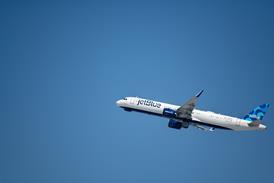Analysts were writing the obituary for the Boeing 747-8 programme last January. When the US Air Force committed to buying the aircraft for an Air Force One replacement, Boeing was expected to cease production after delivering the two VC-25A replacements to the US government in 2017, concluding a proud, 48-year production run.
But neither the USAF nor Boeing appear willing to play by that script.
Boeing chief executive and chairman Jim McNerney announced in April that the company remains committed to building 747-8 freighters and passenger-carrying variants for years to come, even allowing output to decline to as low as one per month, if necessary.
The USAF also released budget documents in February that propose an unusual funding arrangement for the next Air Force One fleet. Rather than pay for both aircraft upfront, service officials plan to make an initial payment in fiscal 2016 on the first aircraft and perhaps complete the acquisition of the second aircraft in 2020. So count the USAF among those who believe the 747-8 assembly line will still exist in five years.
There is some logic to buttress Boeing’s optimism in the 747-8’s longevity, despite a slim backlog of only about 32 aircraft entering the Paris air show.
The air cargo market was devastated for two years by the 2008 financial crisis, weakening the market as the 747-8 was mired in development delays. The market appeared to rebound successfully in 2010, but then remained basically stagnant for the next three years. Hundreds of large freighters were parked in storage in desert parking lots, as their owners awaited a market recovery.
That recovery appears to be happening, although at a slower pace than Boeing may prefer. Global air cargo traffic improved by 4.5% last year and is forecast by IATA to grow at roughly the same pace this year.
“It’s a very, very big deal to us that this market is going up again,” says Boeing 747 vice-president and general manager Bruce Dickinson.
The recovery may not lead to a new wave of 747-8F orders, however. The fastest growing segment of the air cargo market is carried in the bellies of passenger airliners, such as the 787. Some airlines have selected the 777F to replace older 747-8 Freighters recently. Boeing is keeping its options open by controlling production costs. A third rate cut from the original output of two aircraft per month will take effect in August, with monthly deliveries declining to 1.3. Another rate cut is not out of the question.
“We’ve made the production system so efficient that there is room” to reduce the rate again, Dickinson says. “One a month would keep it profitable.”
Source: Flight International























